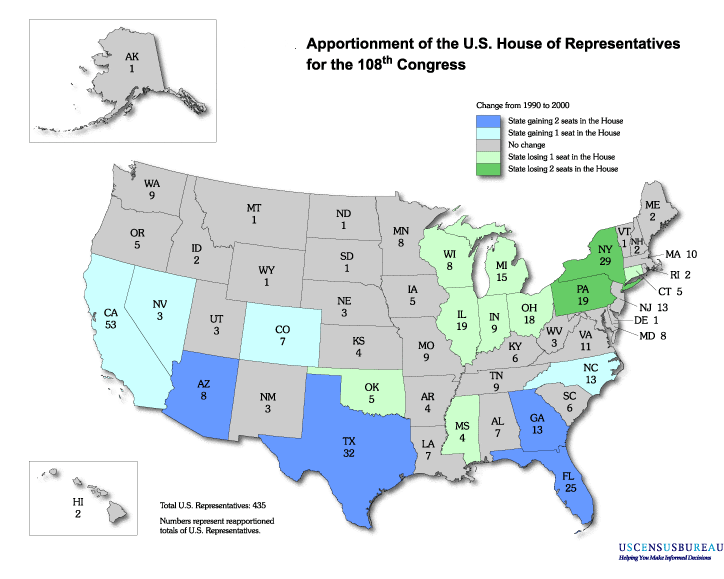| Objective | Datasets | Bibliography | Links |
Objective

After the 2000 Census results were reported, seats in the House of Representatives were reapportioned on the basis of the new population data. As required by Article 1, Section 2 of the Constitution, “Representatives … shall be apportioned among the states within this union according to their respective numbers….” Each state is entitled to one seat, and the remaining seats are allocated on the basis of each state’s share of the total population. Congress provides rules and formulas to determine which states receive the remaining seats. Currently there are 50 states and 435 seats in Congress. Congress currently employs the “method of equal proportions” to allocate seats and determine what to do for a state that is owed a fraction’ of a representative.(That is, if a state is entitled to 4. 4 or 4. 6 representatives, does the state receive 4 or 5?).
Over the course of the history of the republic, the number of states, the number of seats in the House of Representatives, the formula for allocating the seats, and of course the population of the states all have changed. The states have gone from 13 to 50; the size of the House has risen from 105 to 435. There have been 4 methods used to allocate the seats. And the population has grown from 3. 9 million to about 275 million. In other words, these are the four possible variables one needs to consider to undertake the apportionment of the House of Representatives.
The spreadsheets and tables that are linked to this page are designed to serve as a primer on Congressional reapportionment. They contain tables of the population history of the states of the United States from 1790 to the present, a historical table of the apportionment of Congress since 1790, explanations and calculation worksheets for apportioning Congress, and a bibliography of additional research resources.
The reader may wish to browse the historical tables and explanation of apportionment methods, and then try to calculate alternate scenarios for apportioning Congress. Currently we provide 2 methods of apportionment (the method of equal proportions and the method of major fractions). We also allow the reader to put in a test column of state population data to calculate the apportionment of the House. And we provide a worksheet which would allow the reader to create new states, for example, by making Puerto Rico or the District of Columbia states, and observing the impact of adding new states on House apportionment. Finally we provide the reader with the possibility of adding 215 new members to Congress and calculating House apportionment with 650 members.
Congressional apportionment is one of the more fascinating aspects of the American state structure. For most of the history of the republic it required repeated and tedious hand calculations of complicated formulas with very large numbers and fractions. With the availability of good spreadsheet packages to do the calculations and the World Wide Web to display the principles, we hope to bring the principles and calculations to a wider audience.
And we hope therefore, as the 2000 Census results appear, our viewers will take up the task of calculating House apportionments and inspecting the implications of the methods currently in use, and even considering how they might change if Congress so chose.
last updated 4/20/01